Your homemade sticky fly trap works because it exploits flies’ natural behavior patterns and biological weaknesses. Flies can’t resist sugary substances like honey, which provides the energy they need for survival. Once they land on your sticky surface, the adhesive immediately immobilizes them, and they lack the strength to escape. The sweet scent acts as a powerful attractant, while the sticky consistency prevents any chance of freedom. Understanding these principles will help you optimize your trap’s effectiveness.
The Science Behind Sticky Trap Effectiveness
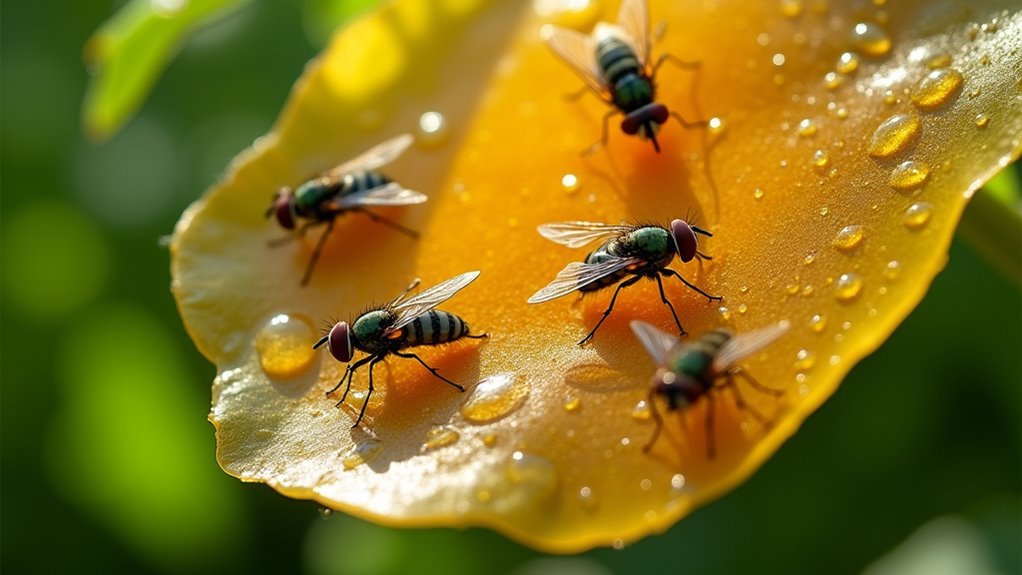
While commercial fly traps can be expensive and contain harsh chemicals, homemade sticky traps offer an effective, eco-friendly alternative that works on simple yet proven scientific principles.
When flies contact the adhesive surface, they’re immediately immobilized and can’t escape. You’ll maximize your trap’s effectiveness by adding attractants like sugar water or honey, which create irresistible lures that draw flies directly to the sticky surface.
Research shows sticky traps can capture significant percentages of target insect populations in your home.
You’ll also benefit from real-time monitoring capabilities—seeing trapped flies gives you immediate feedback about pest activity levels. This visual evidence helps you determine whether your homemade traps are working and if you need additional pest control measures in specific areas.
Understanding Fly Behavior and Attraction Patterns
To create truly effective homemade sticky traps, you’ll need to understand what drives flies to investigate and land on surfaces in the first place. Flies operate primarily through their olfactory system, detecting chemical signals from decaying organic matter and fermentation processes. These scents trigger powerful instinctive responses that attract flies from considerable distances.
You can exploit their visual preferences by incorporating bright colors, particularly yellow and blue, which flies naturally associate with food sources and breeding sites. Their foraging behavior follows predictable patterns – they’re drawn to sugary substances that promise nutrition and energy.
Once flies detect attractive odors or colors, they’ll investigate by landing directly on surfaces. This behavior makes them vulnerable to sticky substances that trap them through surface tension, preventing escape.
Essential Ingredients for Homemade Sticky Fly Traps
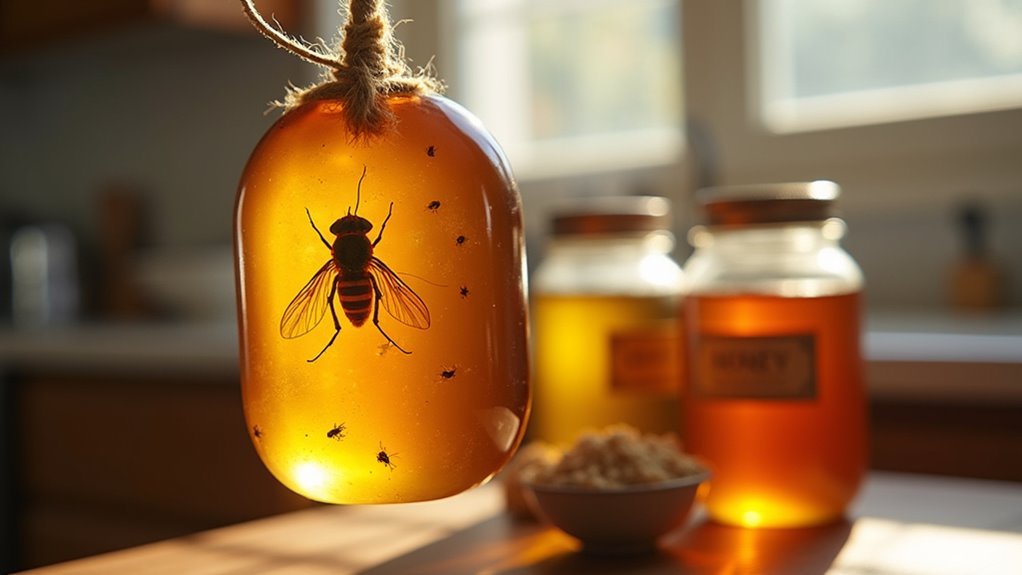
Creating effective homemade sticky fly traps requires just a handful of common household ingredients that work together to attract and capture flies.
You’ll need honey or sugar as your primary base, creating the sticky adhesive that’ll trap flies once they land. Adding water dissolves these sweeteners into an effective solution that saturates your trap material thoroughly.
For the trap surface, you can use scrap paper or cardboard strips that are easily hung in high-activity areas.
To boost attraction power, incorporate apple cider vinegar into your sticky mixture—its distinctive scent acts as a powerful fly magnet.
Finally, string or yarn enables strategic placement where flies congregate most. These simple ingredients create surprisingly effective traps using items you likely already have.
How Honey Creates the Perfect Adhesive Base
Among these basic ingredients, honey stands out as the most effective foundation for your sticky trap mixture. You’ll find that honey’s high sugar content creates an incredibly sticky consistency that makes escape impossible once flies land on it. The natural viscosity works like biological glue, ensuring trapped insects can’t break free from the adhesive surface.
What makes honey particularly effective is its dual function. It doesn’t just trap the flies – it actively lures them in with its sweet, irresistible scent. You’re fundamentally creating a deadly attraction that flies can’t resist.
Unlike harsh synthetic adhesives, honey provides an eco-friendly solution that’s safe around your family and pets while delivering superior trapping results.
The Role of Sugar in Enhancing Fly Attraction
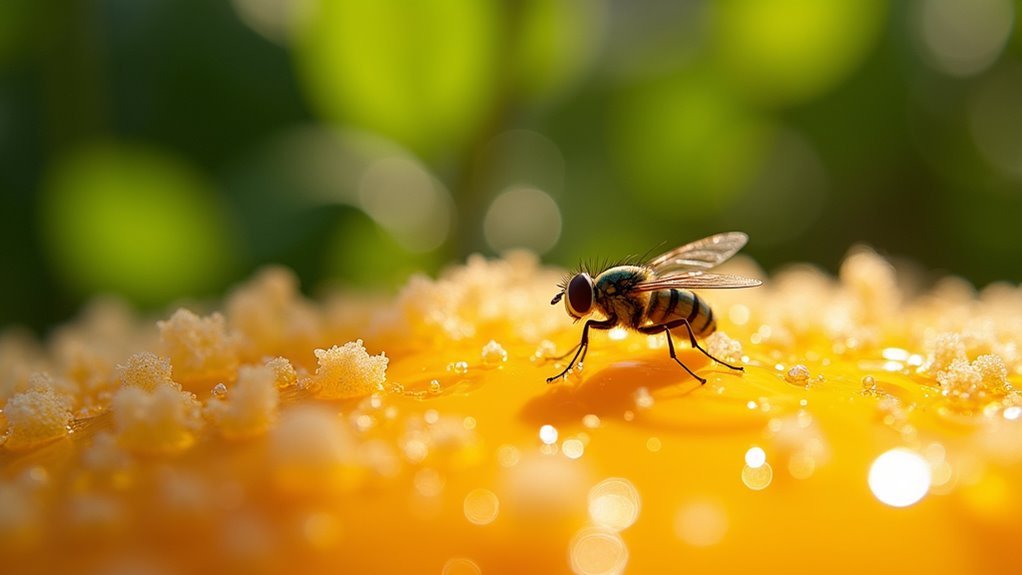
While honey provides an excellent adhesive foundation, adding sugar to your homemade fly trap amplifies its attracting power exponentially.
Sugar’s high energy content acts as a powerful magnet for flies, who can’t resist investigating sweet sources. When you combine sugar with water, you’ll create a syrupy solution that enhances your trap’s sticky properties while dramatically increasing catch rates.
This sugar water mixture doesn’t just attract flies—it masks deterring odors that might keep them away.
Whether you’re building a fruit fly trap or targeting house flies, sugar markedly outperforms non-sugary alternatives. You can boost effectiveness further by adding honey or fruit juices alongside sugar, creating an irresistible combination that draws insects directly into your trap.
Why Water Consistency Matters in Your Mixture
You’ll find that water consistency can make or break your sticky trap’s effectiveness.
Too much water creates a runny mixture that won’t hold flies, while too little makes it impossible to spread evenly across your trap surface.
Getting the right balance guarantees your mixture maintains ideal stickiness without compromising its ability to capture and retain flies.
Proper Water Ratios
Getting the water ratio right determines whether your homemade fly trap becomes a catching powerhouse or a useless mess. The most effective proper water ratios involve combining equal parts honey and water, creating the perfect balance between stickiness and consistency.
When you use too much water, you’ll dilute your sticky mixture and reduce its adhesive properties, allowing flies to escape easily. Your mixture should maintain enough thickness to coat paper strips without dripping off the surface.
Too much water also extends drying time, which can compromise trap effectiveness. You want a consistency that’s thick enough to secure flies permanently while staying on your trap material.
Test your mixture’s thickness before applying – it should flow slowly but not run when tilted.
Avoiding Runny Mixtures
Water consistency becomes your trap’s make-or-break factor when creating sticky fly catching solutions. Too much water dilutes your mixture’s adhesive properties, allowing flies to escape easily.
You’ll want to minimize water content while combining honey and sugar to achieve the perfect viscosity. Your mixture should coat surfaces without dripping off, similar to how sticky tape maintains its hold.
Test consistency by observing whether it spreads evenly yet holds its position. If you’re adding liquid dish soap for enhanced attraction, use just drops rather than generous amounts to prevent over-thinning.
The ideal texture resembles thick syrup that won’t run when applied. Remember, runny mixtures create ineffective traps that frustrate rather than solve your fly problem.
Achieving Optimal Stickiness
While excessive water weakens your trap’s adhesive power, achieving the ideal sticky consistency requires understanding how each ingredient contributes to the mixture’s effectiveness.
Your sticky mixture needs a syrupy texture that maintains strong adhesive properties over time. Sugar and honey work together, creating a viscous surface that prevents flies from escaping once they land.
You’ll know you’ve achieved maximum stickiness when the mixture coats your stirring spoon without dripping off immediately. This consistency guarantees the solution adheres properly to paper strips while remaining tacky enough to capture pests effectively.
The syrupy texture also prevents the trap from drying out quickly, extending its effectiveness.
Monitor your traps regularly and refresh them when the mixture loses its stickiness to maintain peak performance.
Choosing the Right Paper Material for Maximum Results
Success with homemade sticky fly traps starts with selecting the right paper material. You’ll want lightweight options like scrap paper or cardstock for easier handling and better adhesion. The surface texture matters considerably – rough surfaces provide more grip, increasing your capture rate.
Color choice is vital for your chosen paper. Yellow and blue hues attract flies naturally, making your traps more effective than plain white paper.
| Paper Type | Surface Texture | Effectiveness Rating |
|---|---|---|
| Cardstock | Rough | High |
| Scrap Paper | Medium | Medium-High |
| Construction Paper | Smooth | Medium |
| Newspaper | Rough | High |
Cut strips approximately 2 inches wide to maximize surface area while maintaining manageability for hanging. This width guarantees you’re capturing the most flies possible without creating unwieldy traps.
Proper Preparation Techniques for Long-Lasting Stickiness
Once you’ve selected your paper material, creating the perfect sticky solution becomes your next priority.
Mix 1/4 cup honey with 1/4 cup sugar and 1/8 cup water to form your trap’s foundation. This combination creates an irresistible lure that flies can’t escape once they make contact.
Cut your chosen paper into manageable 2-inch wide by 5-6 inch long strips. Completely saturate each strip in your sticky mixture, ensuring every surface is thoroughly coated.
Here’s the vital step most people skip: allow the strips to dry completely before hanging. This drying process maximizes stickiness and prevents dripping.
Monitor your traps regularly and replace the paper strips when they’re full of flies or lose their tackiness to maintain consistent effectiveness.
Strategic Placement for Optimal Fly Capture
You’ll maximize your trap’s effectiveness by positioning it where flies congregate most frequently.
Target areas near food preparation zones, fruit bowls, and trash cans where flies naturally gather to feed.
Don’t forget to place traps at entry points like doorways and windows, and hang them at the ideal height of 3-5 feet where flies typically cruise.
Near Food Sources
When you position your homemade sticky traps near food sources like fruit bowls, garbage bins, or pet food dishes, you’re targeting flies where they’re most active and vulnerable.
These locations naturally attract flies with strong food odors that draw them in consistently. Your fruit fly traps become considerably more effective when placed within 5-10 feet of breeding and feeding areas, where flies concentrate their activity.
The sticky surfaces intercept flies as they’re drawn to ripe or rotting food scents nearby.
Kitchen counters, dining areas, and anywhere food waste accumulates become prime real estate for trap placement. You’ll capture more flies by strategically positioning traps in these high-activity zones rather than random locations.
Remember to regularly refresh your traps’ sticky surfaces and replace bait to maintain their effectiveness in these food-rich environments.
Entry Point Locations
Beyond targeting food sources, the most strategic locations for your sticky traps are the actual entry points where flies infiltrate your home. You’ll maximize captures by positioning traps near doors, windows, and other access points where flies naturally attempt entry.
| Entry Point | Trap Placement Strategy |
|---|---|
| Doors | Mount on door frames or place on nearby surfaces |
| Windows | Position on windowsills or hang from window hardware |
| Vents/Gaps | Secure traps adjacent to openings in walls or screens |
This strategic placement works because flies are attracted to light and air currents from these openings. You’re fundamentally creating a barrier that intercepts them before they establish themselves inside. The key is catching them during their initial entry attempt, when they’re most vulnerable and haven’t yet dispersed throughout your living space.
Height and Accessibility
Strategic height placement transforms your sticky traps from random pest control tools into precision fly-catching instruments. You’ll achieve maximum effectiveness by positioning traps at waist to head height, matching common fly activity zones where they naturally cruise through your living space.
Accessibility becomes essential when you place traps near food sources like kitchens and dining areas. Flies gravitate toward these locations, making your traps irresistible targets.
Choose well-lit areas since flies are naturally drawn to light, increasing encounter rates with your sticky surfaces.
Avoid cluttered spaces that create obstacles between flies and traps. Clear pathways guarantee unimpeded access to your catching devices.
Monitor fly patterns regularly and reposition traps accordingly. This strategic approach maximizes capture rates by keeping traps accessible and ideally placed.
Comparing Homemade Vs Commercial Sticky Traps
While commercial sticky traps offer convenience and professional packaging, you’ll find that homemade versions can match their effectiveness at a fraction of the cost. Research shows homemade sticky fly traps can attract and kill various fly species just as effectively as store-bought alternatives when properly optimized.
| Feature | Homemade Traps | Commercial Traps |
|---|---|---|
| Cost | $0.50-$1.00 | $3.00-$8.00 |
| Customization | Full control over size/shape | Fixed dimensions |
| Chemical Safety | Chemical-free options available | May contain harmful substances |
You can customize your traps’ size and shape to fit specific spaces, something commercial options can’t offer. Unlike many commercial versions, you’ll avoid harmful chemicals by using natural ingredients like honey and sugar water. Plus, you can enhance their aesthetic appeal with decorative paper, seamlessly blending them into your home decor.
Common Mistakes That Reduce Trap Effectiveness
Even experienced DIY enthusiasts can sabotage their fly-catching efforts through seemingly minor oversights that greatly impact trap performance.
Understanding these pitfalls helps you maximize your homemade solutions’ effectiveness against fruit flies and other pests.
Avoiding common DIY trap mistakes ensures your homemade pest control solutions actually catch flies instead of letting them escape.
Critical mistakes that compromise trap effectiveness:
- Over-diluting sticky mixtures – Weak adhesives allow flies to escape rather than get trapped, reducing your catch rate markedly.
- Poor trap placement – Positioning traps away from windows, garbage areas, or food sources means fewer flies will encounter them.
- Neglecting bait maintenance – Old, stale attractants lose their appeal, making flies less likely to approach your carefully crafted traps.
- Ignoring surface cleanliness – Dusty, debris-covered sticky surfaces repel flies instead of attracting them to land.
Environmental Benefits of DIY Sticky Solutions
Beyond their pest-control effectiveness, your homemade sticky fly traps deliver significant environmental advantages that commercial alternatives can’t match.
You’re using biodegradable materials instead of plastic components that persist in landfills for decades. Natural ingredients like honey and sugar eliminate chemical exposure risks to your family and pets while avoiding the environmental harm associated with pesticides that disrupt local ecosystems.
When you create DIY traps, you’re actively recycling household materials and reducing consumption. This approach aligns perfectly with sustainable living practices.
You’re taking direct action to manage pests responsibly, fostering environmental stewardship that considers ecological balance. Your homemade solutions protect both your home and the broader environment, proving that effective pest control doesn’t require compromising nature’s delicate systems.
Maintenance and Replacement Tips for Best Results
Most homemade sticky fly traps require replacement every 1-2 weeks to maintain peak effectiveness, though you’ll need to monitor them closely for best results.
Monitor your homemade sticky fly traps weekly and replace them every 1-2 weeks for maximum effectiveness against household pests.
The adhesive naturally loses its stickiness over time, reducing your trap’s ability to catch flies.
Here’s your essential maintenance checklist:
- Check trap saturation weekly – Replace overcrowded traps immediately to prevent flies from escaping and maintain cleanliness.
- Refresh bait every 3-4 days – Clean and replace honey or sugar solutions to keep attracting flies effectively.
- Position strategically – Place traps near high-activity areas like fruit bowls and garbage bins for maximum catch rates.
- Store properly when unused – Keep spare traps in cool, dry places to prevent adhesive deterioration.
Regular maintenance guarantees your DIY traps continue working efficiently.
Frequently Asked Questions
Do Sticky Fly Traps Really Work?
Yes, you’ll find sticky fly traps effectively reduce fly populations by capturing them on adhesive surfaces. They’re particularly useful when you place them near food sources or entry points where flies commonly gather.
Do Homemade Fly Traps Work?
You’ll find homemade fly traps work effectively when you use sweet attractants like honey or sugar solutions. They’re cost-effective, non-toxic, and capture flies successfully if you place them strategically.
Do Bugs Suffer on Sticky Traps?
You’re right to wonder about bug suffering on sticky traps. Research suggests insects can experience distress when trapped, struggling to escape while potentially dying slowly from exhaustion or dehydration over extended periods.
Why Are My Sticky Fly Traps Not Working?
You’re likely placing traps in wrong locations with low fly traffic. Check if your adhesive’s sticky enough, bait’s appealing to flies, and environmental factors like humidity aren’t reducing effectiveness.
In Summary
You’ve discovered that homemade sticky fly traps work because they exploit flies’ natural attraction to sweet substances while using honey’s superior adhesive properties. You’ll save money compared to commercial options and reduce chemical exposure in your home. Don’t forget you’ll need to replace traps regularly and position them strategically for maximum effectiveness. Your DIY approach isn’t just cost-effective—it’s environmentally friendly and surprisingly more efficient than store-bought alternatives.


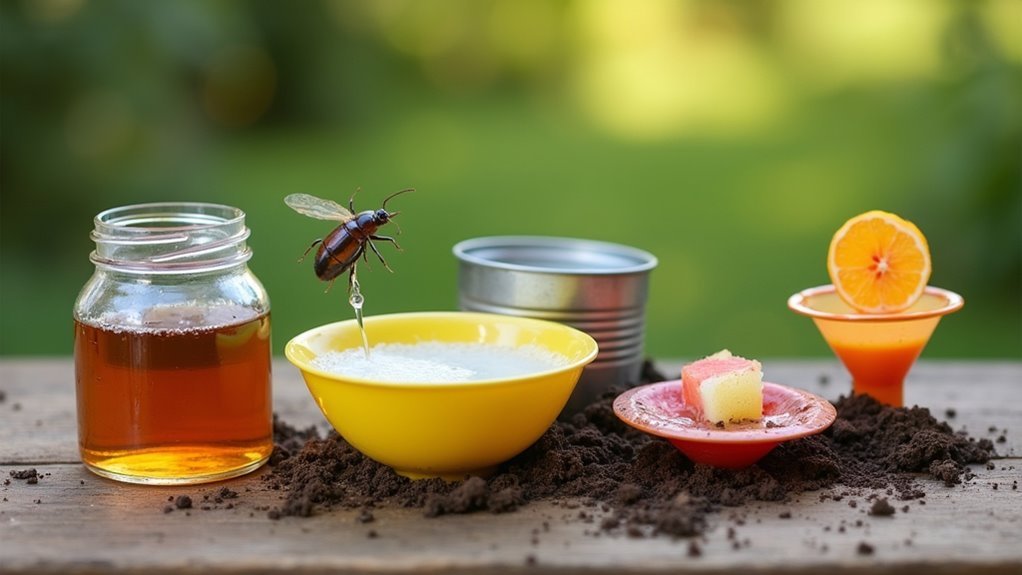
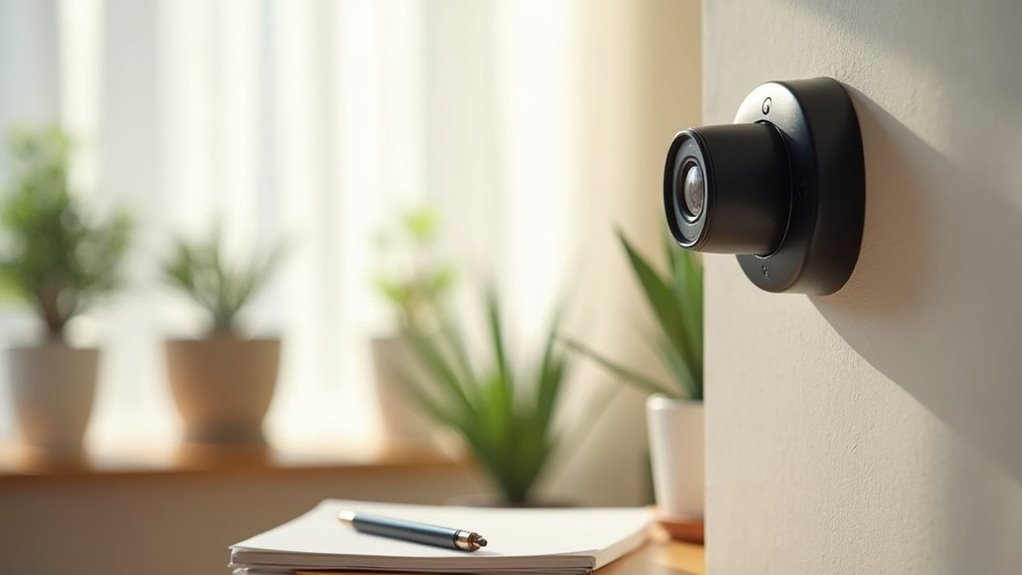
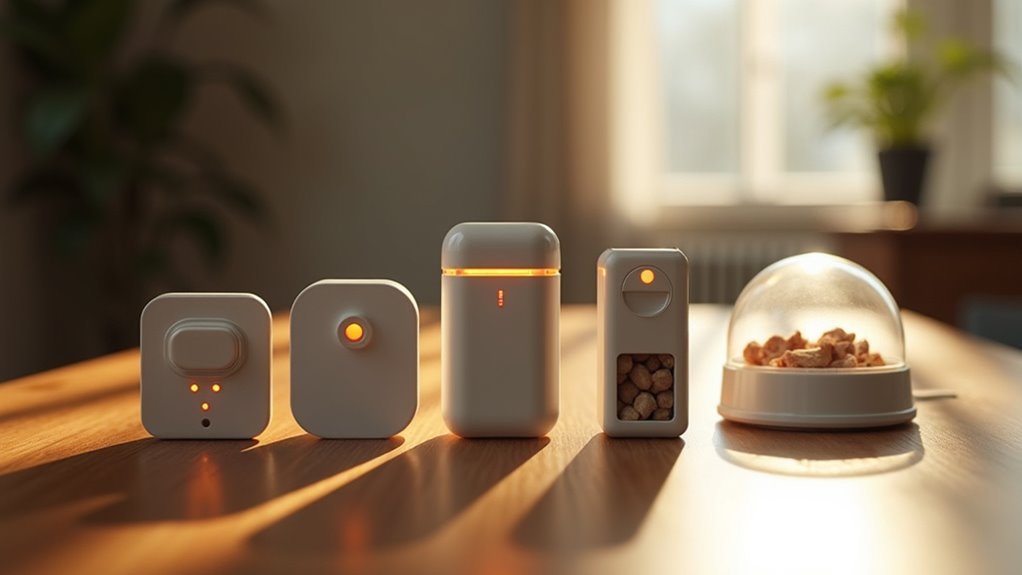
Leave a Reply